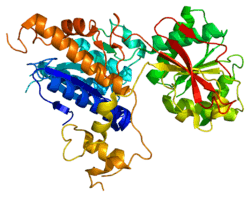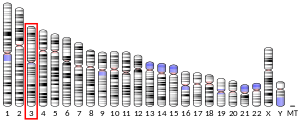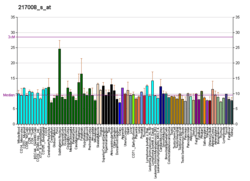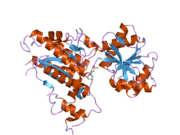Metabotropic glutamate receptor 7
Metabotropic glutamate receptor 7 is a protein that in humans is encoded by the GRM7 gene.[5][6][7]
Function
L-glutamate is the major excitatory neurotransmitter in the central nervous system and activates both ionotropic and metabotropic glutamate receptors. Glutamatergic neurotransmission is involved in most aspects of normal brain function and can be perturbed in many neuropathologic conditions. The metabotropic glutamate receptors are a family of G protein-coupled receptors, that have been divided into 3 groups on the basis of sequence homology, putative signal transduction mechanisms, and pharmacologic properties. Group I includes GRM1 and GRM5 and these receptors have been shown to activate phospholipase C. Group II includes GRM2 and GRM3 while Group III includes GRM4, GRM6, GRM7 and GRM8. Group II and III receptors are linked to the inhibition of the cyclic AMP cascade but differ in their agonist selectivities. Alternative splice variants of GRM8 have been described but their full-length nature has not been determined.[7]
Ligands
Agonists
- AMN082: allosteric agonist;[8][9] induces rapid internalization;[10] non-glutamatergic binding component[9]
Negative allosteric modulator
- ADX-71743[12]
Clinical
Mutations in both copies have been associated with developmental and epileptic encephalopathy, microcephaly, hypomyelination and cerebral atrophy.[14]
References
- GRCh38: Ensembl release 89: ENSG00000196277 - Ensembl, May 2017
- GRCm38: Ensembl release 89: ENSMUSG00000056755 - Ensembl, May 2017
- "Human PubMed Reference:". National Center for Biotechnology Information, U.S. National Library of Medicine.
- "Mouse PubMed Reference:". National Center for Biotechnology Information, U.S. National Library of Medicine.
- Okamoto N, Hori S, Akazawa C, Hayashi Y, Shigemoto R, Mizuno N, Nakanishi S (February 1994). "Molecular characterization of a new metabotropic glutamate receptor mGluR7 coupled to inhibitory cyclic AMP signal transduction". J Biol Chem. 269 (2): 1231–6. PMID 8288585.
- Makoff A, Pilling C, Harrington K, Emson P (January 1997). "Human metabotropic glutamate receptor type 7: molecular cloning and mRNA distribution in the CNS". Brain Res Mol Brain Res. 40 (1): 165–70. doi:10.1016/0169-328X(96)00110-6. PMID 8840028.
- "Entrez Gene: GRM7 glutamate receptor, metabotropic 7".
- Li X, Gardner EL, Xi ZX (2008). "The Metabotropic Glutamate Receptor 7 (mGluR7) Allosteric Agonist AMN082 Modulates Nucleus Accumbens GABA and Glutamate, but not Dopamine, in Rats". Neuropharmacology. 54 (3): 542–51. doi:10.1016/j.neuropharm.2007.11.005. PMC 2410088. PMID 18155073.
- Palucha A, Klak K, Branski P, van der Putten H, Flor PJ, Pilc A (2007). "Activation of the mGlu7 receptor elicits antidepressant-like effects in mice". Psychopharmacology. 194 (4): 555–62. doi:10.1007/s00213-007-0856-2. PMID 17622518.
- Pelkey KA, Yuan X, Lavezzari G, Roche KW, McBain CJ (2007). "mGluR7 undergoes rapid internalization in response to activation by the allosteric agonist AMN082". Neuropharmacology. 52 (1): 108–17. doi:10.1016/j.neuropharm.2006.07.020. PMID 16914173.
- Suzuki G, Tsukamoto N, Fushiki H, Kawagishi A, Nakamura M, Kurihara H, Mitsuya M, Ohkubo M, Ohta H (2007). "In vitro pharmacological characterization of novel isoxazolopyridone derivatives as allosteric metabotropic glutamate receptor 7 antagonists". J. Pharmacol. Exp. Ther. 323 (1): 147–56. doi:10.1124/jpet.107.124701. PMID 17609420.
- Kalinichev M, Rouillier M, Girard F, et al. (2013). "ADX71743, a potent and selective negative allosteric modulator of metabotropic glutamate receptor 7: in vitro and in vivo characterization". J. Pharmacol. Exp. Ther. 344 (3): 624–36. doi:10.1124/jpet.112.200915. PMID 23257312.
- Dev KK, Nakajima Y, Kitano J, Braithwaite SP, Henley JM, Nakanishi S (October 2000). "PICK1 interacts with and regulates PKC phosphorylation of mGLUR7". J. Neurosci. 20 (19): 7252–7. doi:10.1523/JNEUROSCI.20-19-07252.2000. PMC 6772771. PMID 11007882.
- Marafi D, Mitani T, Isikay S, Hertecant J, Almannai M, Manickam K, Abou Jamra R, El-Hattab AW, Rajah J, Fatih JM, Du H, Karaca E, Bayram Y, Punetha J, Rosenfeld JA, Jhangiani SN, Boerwinkle E1, Akdemir ZC, Erdin S, Hunter JV, Gibbs RA, Pehlivan D, Posey JE, Lupski JR (2020) Biallelic GRM7 variants cause epilepsy, microcephaly, and cerebral atrophy. Ann Clin Transl Neurol
Further reading
- Scherer SW, Duvoisin RM, Kuhn R, Heng HH, Belloni E, Tsui LC (1997). "Localization of two metabotropic glutamate receptor genes, GRM3 and GRM8, to human chromosome 7q". Genomics. 31 (2): 230–3. doi:10.1006/geno.1996.0036. PMID 8824806.
- Flor PJ, Van Der Putten H, Rüegg D, Lukic S, Leonhardt T, Bence M, Sansig G, Knöpfel T, Kuhn R (1997). "A novel splice variant of a metabotropic glutamate receptor, human mGluR7b". Neuropharmacology. 36 (2): 153–9. doi:10.1016/S0028-3908(96)00176-1. PMID 9144652.
- Wu S, Wright RA, Rockey PK, Burgett SG, Arnold JS, Rosteck PR, Johnson BG, Schoepp DD, Belagaje RM (1998). "Group III human metabotropic glutamate receptors 4, 7 and 8: molecular cloning, functional expression, and comparison of pharmacological properties in RGT cells". Brain Res. Mol. Brain Res. 53 (1–2): 88–97. doi:10.1016/S0169-328X(97)00277-5. PMID 9473604.
- Nakajima Y, Yamamoto T, Nakayama T, Nakanishi S (1999). "A relationship between protein kinase C phosphorylation and calmodulin binding to the metabotropic glutamate receptor subtype 7". J. Biol. Chem. 274 (39): 27573–7. doi:10.1074/jbc.274.39.27573. PMID 10488094.
- O'Connor V, El Far O, Bofill-Cardona E, Nanoff C, Freissmuth M, Karschin A, Airas JM, Betz H, Boehm S (1999). "Calmodulin dependence of presynaptic metabotropic glutamate receptor signaling". Science. 286 (5442): 1180–4. doi:10.1126/science.286.5442.1180. hdl:11858/00-001M-0000-0012-FB4D-F. PMID 10550060.
- Barbon A, Ferraboli S, Barlati S (2000). "Assignment of the human metabotropic glutamate receptor gene GRM7 to chromosome 3p26.1→p25.2 by radiation hybrid mapping". Cytogenet. Cell Genet. 88 (3–4): 288. doi:10.1159/000015541. PMID 10828612.
- Dev KK, Nakajima Y, Kitano J, Braithwaite SP, Henley JM, Nakanishi S (2001). "PICK1 interacts with and regulates PKC phosphorylation of mGLUR7". J. Neurosci. 20 (19): 7252–7. doi:10.1523/JNEUROSCI.20-19-07252.2000. PMID 11007882.
- Bolonna AA, Kerwin RW, Munro J, Arranz MJ, Makoff AJ (2001). "Polymorphisms in the genes for mGluR types 7 and 8: association studies with schizophrenia". Schizophr. Res. 47 (1): 99–103. doi:10.1016/S0920-9964(99)00235-2. PMID 11163549.
- Hirbec H, Perestenko O, Nishimune A, Meyer G, Nakanishi S, Henley JM, Dev KK (2002). "The PDZ proteins PICK1, GRIP, and syntenin bind multiple glutamate receptor subtypes. Analysis of PDZ binding motifs". J. Biol. Chem. 277 (18): 15221–4. doi:10.1074/jbc.C200112200. PMID 11891216.
- Enz R (2002). "The actin-binding protein Filamin-A interacts with the metabotropic glutamate receptor type 7". FEBS Lett. 514 (2–3): 184–8. doi:10.1016/S0014-5793(02)02361-X. PMID 11943148.
- Saugstad JA, Yang S, Pohl J, Hall RA, Conn PJ (2002). "Interaction between metabotropic glutamate receptor 7 and alpha tubulin". J. Neurochem. 80 (6): 980–8. doi:10.1046/j.0022-3042.2002.00778.x. PMC 2925652. PMID 11953448.
- Schulz HL, Stohr H, Weber BH (2002). "Characterization of three novel isoforms of the metabotrobic glutamate receptor 7 (GRM7)". Neurosci. Lett. 326 (1): 37–40. doi:10.1016/S0304-3940(02)00306-3. PMID 12052533.
- Kobayashi Y, Akiyoshi J, Kanehisa M, Ichioka S, Tanaka Y, Tsuru J, Hanada H, Kodama K, Isogawa K, Tsutsumi T (2007). "Lack of polymorphism in genes encoding mGluR 7, mGluR 8, GABA(A) receptor alfa-6 subunit and nociceptin/orphanin FQ receptor and panic disorder". Psychiatr. Genet. 17 (1): 9. doi:10.1097/YPG.0b013e32801118bc. PMID 17167337.
This article incorporates text from the United States National Library of Medicine, which is in the public domain.






